Note to readers: Porsche article originally published October 1, 2020 and updated January 5, 2022.
Long before he was a five-term mayor of Hapeville, a southside city of 6,500 bordering the world’s busiest airport today, Alan Hallman grew up there. He recalls the blue-collar Ford Motor Company plant, a Hapeville landmark, as one would an old neighbor. It was the city’s second largest employer (behind Delta Air Lines), the biggest tax generator, largest water user, and generally part of Hapeville’s fabric for 60 years—until its closure in 2006 and subsequent demolition.
Despite his hometown’s automotive roots, Hallman had a gobsmacked reaction one day in 2011 when he caught wind of what might replace the Ford plant. In a hush-hush meeting with a broker, Hallman was told Porsche Cars North America was considering the site for its national headquarters.
“I literally laughed out loud,” says Hallman today, laughing again. “I said, ‘That’s the craziest thing I’ve ever heard in my life!’”
Fast forward nine years, and Porsche is celebrating the fifth anniversary of a multifaceted facility that’s not only the largest investment the company has ever made outside Germany—but a boon to under-the-radar, historic places like Hapeville with big ambitions of gaining more ITP notoriety. The sports car manufacturer, in fact, has worked closely with Hallman and his administration in ways the mayor could have never predicted.
When the curtain lifted on the $100-million Porsche Experience Center Atlanta in 2015, project leaders said they’d considered more than 70 other locations for their North American headquarters, previously housed in Sandy Springs. Ultimately, though, Atlanta’s airport, skilled workforce, transit infrastructure, along with city and state financial support, won out.
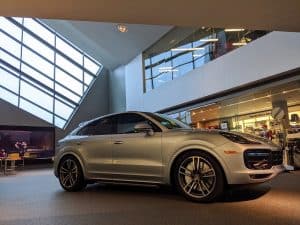
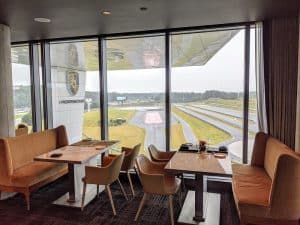
The 27-acre complex is the first piece of what’s envisioned as “Aerotropolis Atlanta,” a mixed-use mini city. Beyond offices and hotel rooms, Porsche’s section includes a 1.6-mile track that’s like a driver’s playground in the backyard, a classic car gallery, simulator lab, fine-dining restaurant, and a swanky remodeled cafe, with another multi-million-dollar component having broken ground in recent days. Initially, the facility was expected to host about 30,000 visitors per year—but that estimate, in racing terms, has been lapped. And places like Hapeville have reaped the benefits.
For automotive enthusiasts and Porsche customers with the cash—or Regular Joe tourists checking off boxes on their bucket lists—the popularity isn’t hard to understand.
During a recent visit on a cool, overcast morning, I exited Interstate 75 onto Porsche Avenue (formerly Henry Ford II Avenue) and marveled again at the modernistic headquarters building and Kimpton hotel next door. Both were designed by HOK, the architecture firm behind Mercedes-Benz Stadium, and the former once acted as Avengers Tower in Captain America: Civil War. At the gated entrance, Google Maps buzzed my smartphone with a suggestion: “EXPLORE HAPEVILLE.” The city’s historic main drag is just a few blocks down the street.
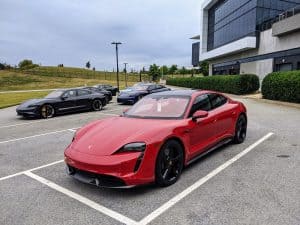
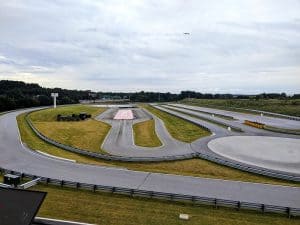
Following a temperature scan that’s part of pandemic protocol—like mandatory masks, social distancing, and thorough cleaning of vehicles with sanitizing vapors—I was led to the track to meet my car for the next 90 minutes: a stunning rendition of Porsche’s first electric vehicle and one of the fastest cars it’s ever produced, the Taycan Turbo S, in Carmike red with 21-inch black wheels. I’d driven a 911 Carrera S, Porsche’s legendary workhorse, on the course before. A few fluorescent 911s are pictured on a billboard outside the facility, exclaiming to so many visitors, “Exhilaration Comes Standard.” But I was in for a futuristic driving experience that renders that phrase an understatement, to say the least.
…
Generations of Atlantans recall the boxy Ford plant standing next to I-75, just south of downtown. But in October 2006, the company rolled its last Ford Taurus off the line, closing the plant and purging about 2,000 jobs as part of a nationwide cost-saving tactic. Hallman, the Hapeville mayor, told media at the time Ford’s decision was a “very disappointing… setback” for the entire state. His city, after all, had invested thousands of dollars and hundreds of manhours in devising ways to try to keep Ford in operation there, as it had been since 1947.
Jacoby Development, the initial builders of Atlantic Station, swooped in to buy the site just after Ford had departed, but the move was ill-timed. The Great Recession imperiled the world’s economy just after Jacoby closed, and Hallman recalls years of grandiose ideas going nowhere after that.
“They had various projects they talked about,” says the mayor, “but everything fell apart, and fell apart again.”
Porsche’s North American operations had been headquartered on Atlanta’s more affluent northside since 1998, but by 2010 the company began scouting sites for expansion. Ground broke on the new facility—it straddles Hapeville and Atlanta city limits, touching both Fulton and Clayton counties—two years later, as the recession’s doldrums faded. Upon its opening, Hallman and his constituents noticed something different: Swinging through, say, Chick-fil-A for lunch, you’d see European sports cars everywhere. In little old Hapeville.
After five years, the experience center has counted more than 270,000 visitors—nearly doubling initial expectations—with numbers trending quickly up to 6,400 per month in pre-pandemic 2019. (Sixty-eight percent of them are not Porsche owners, per the company.) That’s on top of 500 permanent employees, with more jobs on the way.
Hallman says the “halo effect”—the economic boost from spillover tourism in the area—has been “huge.”
…

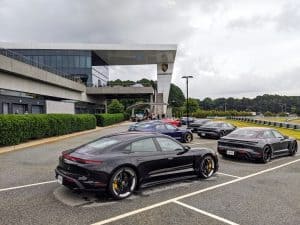
Back on the track, a pandemic silver-lining immediately presents itself: Only one person can safely be in cars at a time now, so visiting drivers have Porsches to themselves. Coaches are in lead cars, giving instructions via radio instead of riding shotgun, and it’s much easier to visually follow their lines while blazing around the course.
Speaking of blazing…
The Taycan (pronounced “tie con”) translates to “spirited young horse” in Turkish, and that’s like calling Mount Everest kind of tall. The car is a marvel. Like all electric vehicles, it’s relatively heavy (north of 5,000 pounds, equivalent to a beefy Ford F-150), but the Turbo S model nimbly inhales corners and rockets from 0 to 60 mph in what professional reviewers have pegged at 2.4 seconds. With sticky launch control, the Taycan’s 750 horsepower took me from a standstill to about 85 mph in a hair under four seconds, per my calculations, before I ran out of straightaway track.
What’s that feel like? The car doesn’t just pin you to the artfully stitched drivers seat—it pulls your eyebrows apart from each other, in the most wonderfully pleasurable way. It’s like your major organs are momentarily thrust into the backseat, your breath stolen, your eyelids gone, as you cling to the wheel of a quietly whirring, intergalactic rocket. Yes, it feels like Hans Solo’s starship hitting lightspeed, only instead of planets, I-75 and those McDonald’s arches across the street are blurring around you. In my case, punching the throttle conjured an instant return to boyhood, with uncontrollable giggling and ridiculous expressions: “Hoo-eee!” and “Woo-hoo-hoo-hoo!”
Such an experience doesn’t come cheap, of course. Romping with the top-shelf Taycan model costs $650 for an hour and a half, although similar experiences in a sporty Boxster, for example, begin at $365, and a 20-percent discount is currently being offered to Georgia residents. The Taycan, however, makes a case for justifying the splurge. That daffy, happy, awestruck sensation lasted for hours after I’d left the track, and the adrenaline surge was so strong I could barely type about it.
…
Nobody’s tracking Porsche’s specific impact on places like Hapeville, and the mayors of nearby College Park and East Point didn’t respond to requests for comment. Hallman isn’t aware of any Hapeville residents who’ve landed jobs at Porsche, though he’s seen Porsche employees buy homes in Hapeville, College Park, and Peachtree City to the south, adding: “We’ve had a pretty good draw of folks moving within close proximity of the facility.”
Porsche’s impact on Hapeville’s restaurants and small businesses has been more pronounced, as the city’s worked to position itself as a haven for artists, brewers, and food entrepreneurs in recent years. Indeed, despite six months of pandemic malaise, the downtown corridor the mayor described as “pretty dead” in the past remains in a state of blossom, with newer eateries, boutique shops, and public art installations, including a campaign of vibrant, oversized butterflies. Porsche employees and tourists are “definitely helping our downtown area, and that’s something Hapeville’s needed for a long time,” says Hallman. “Between that and our initiatives to capitalize on making Hapeville an arts destination, our downtown is alive at night, and that’s good for us.”
The automaker’s investment in the headquarters complex, on land that’s technically in Hapeville, continued this month, as Porsche broke ground on a nearly 21,000-square-foot service facility, one of only two such centers in the U.S. That’s the first facet of a planned multi-million-dollar expansion that will more than double Porsche’s footprint to 60 acres in coming years, incorporating a Porsche Classic Factory Restoration facility, a parking garage, and an extension of the track. In a press release, Atlanta Mayor Keisha Lance Bottoms predicted the expansion will strengthen the city’s economy “through highly skilled and middle-wage opportunities” while further cementing “Atlanta’s reputation as a premiere international hub.”
It’ll also bring Porsche physically closer to Hapeville, where the mayor says the automaker’s employees have been active in volunteering at the elementary school, in sponsorships for various city projects, and even picking up trash during clean and beautiful campaigns.
“They’re great partners, and they have embraced our community,” says Hallman. “We’re proud a little small town like Hapeville is able to attract an international player like that.”
Porsche Experience Center Expansion Update
The Porsche Experience Center in Atlanta is in the process of expanding! Construction is underway on a second track that effectively doubles the length of the existing driver development course. The new section can be driven on its own or in combination with the existing track and adds features inspired by some of the world’s best roads and racing turns – designed to give both the drivers and the cars an intense workout. The project is a cornerstone of a multi-million dollar investment in further developing the headquarters campus of Porsche Cars North America, Inc. (PCNA).
The track expansion is a portion of the 33-acre site development adjacent to the existing 27-acre headquarters, which first opened in 2015. Construction will be ongoing through 2023 and includes a new Porsche Classic Factory Restoration facility, a parking deck and the already-opened Porsche Service Center South Atlanta.
…
The Porsche Experience Center Atlanta offers several drivetimes on most weekdays and weekends, with a 20-percent discount for Georgia residents. For more information, visit www.porschedriving.com/atlanta.
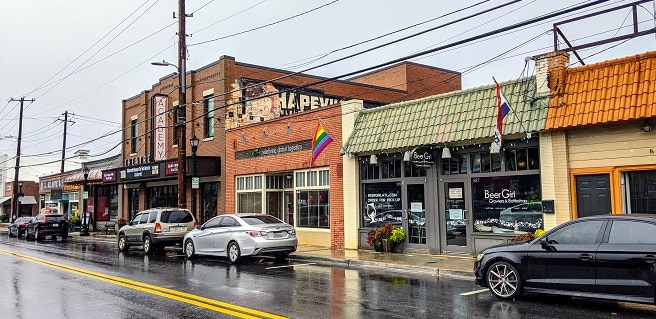
Thank you for a nice story about our city
YES!!! HAPEVILLE REALLY IS A “JEWELL”, A DIAMOND IN THE RUFF! THANK YOU!
Im SOLD! As a Hapeville resident, business owner and realtor having sold over 30% of the homes here in 2021, I can say without hesitation that this is the greatest little city in the state. To be so close to everything Atlanta offers yet in a safe, walkable arts district with visitors and executives from all over the world puts Hapeville in a distinct position as a truly liveable AND lovable town. Congratulations to Mayor Hallman and the past and current leadership for embracing smart growth and creating a thriving atmosphere for commerce and lifestyle.